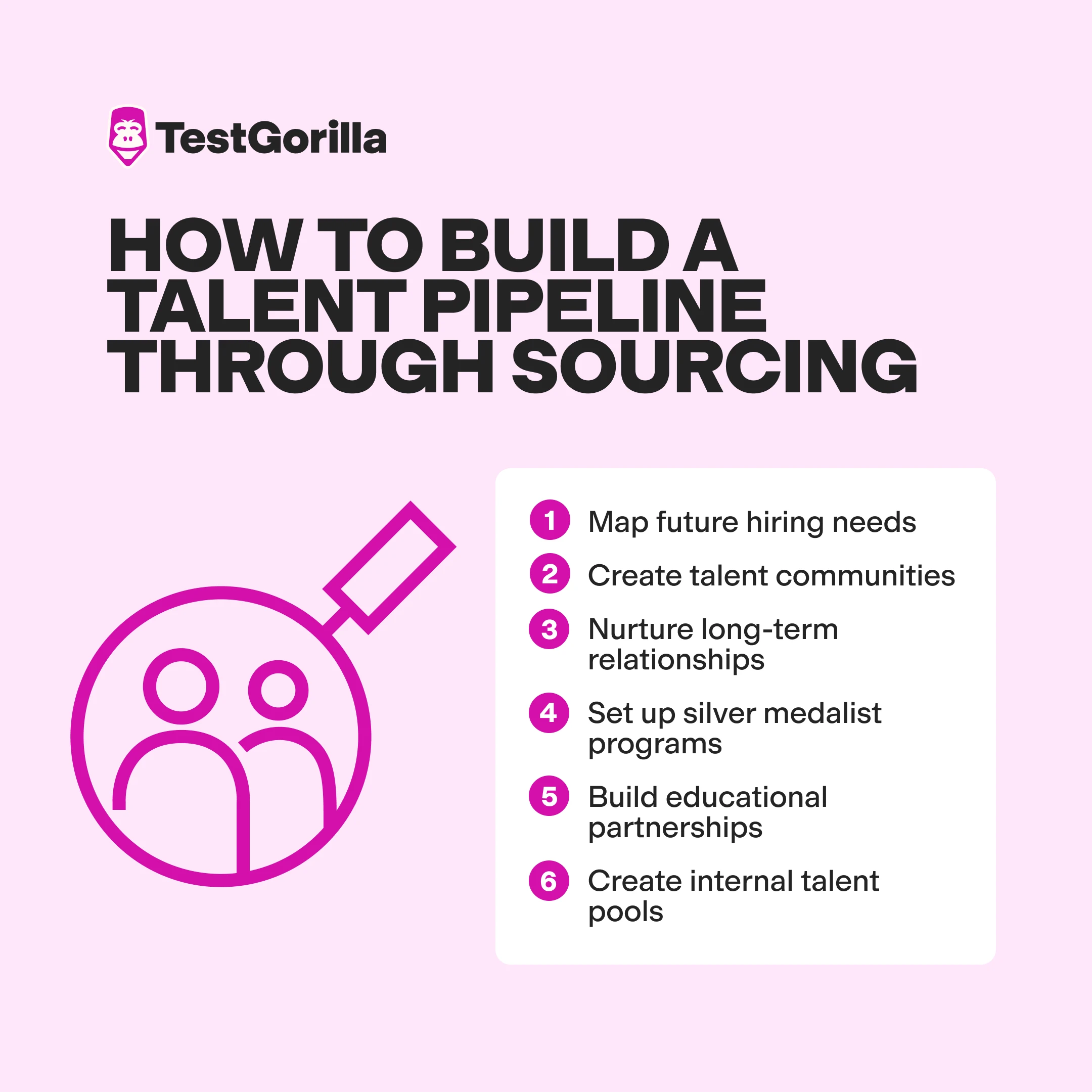Attracting the most qualified candidates to work for your company and sourcing top-performing individuals can feel like an uphill trek.
Budget constraints, a limited pool of job seekers, and a lack of engagement from passive candidates are just some of the challenges of recruiting teams and hiring managers.
Adopting a proactive approach instead of a reactive one through talent sourcing is key to gaining a competitive edge.
How can your business streamline hiring and effectively source candidates?
This guide explores candidate sourcing, where to begin, and candidate sourcing strategies to help boost your recruitment pipeline.
Table of contents
- What is candidate sourcing in the hiring process?
- Why is candidate sourcing important in recruitment?
- What is the difference between sourcing and recruiting?
- Where to begin the candidate sourcing process
- What tools are available to source and find qualified candidates?
- Candidate sourcing strategies you can start today
- How to build a talent pipeline through sourcing
- Best practices for diverse and inclusive candidate sourcing
- Common sourcing challenges and how to overcome them
- Find the right candidates fast through smart sourcing
What is candidate sourcing in the hiring process?
Candidate sourcing is the proactive search for potential candidates to fill current job openings and build talent pipelines.This method is more effective than just posting an online ad and waiting for applicants to come to you.
Sourcing efforts allow HR reps and recruiters to find candidates that are not actively seeking new roles but are open to exploring new opportunities.
Why is candidate sourcing important in recruitment?
Candidate sourcing is crucial in hiring because:
You reach more people: By looking beyond active job seekers, you access a bigger talent pool and increase your chances of finding the perfect match.
You hire faster: Proactive sourcing lets you identify and engage qualified candidates quickly, reducing time-to-hire.
You get better hires: When you actively search for candidates, you can evaluate their skills and cultural fit before the interview stage.
You beat the competition: Good sourcing helps you connect with top talent before your competitors discover them.
You build a talent bank: Regular sourcing creates a pre-vetted candidate pool ready for future openings.
The best insights on HR and recruitment, delivered to your inbox.
Biweekly updates. No spam. Unsubscribe any time.
What is the difference between sourcing and recruiting?
Sourcing and recruiting are two integral pillars of the talent acquisition process.
Sourcing involves actively seeking potential candidates with the necessary skills and qualifications. On the other hand, recruiting involves screening candidates, conducting the interview process, and hiring the best-fit individuals.
Think of sourcing as casting a wide net to discover and entice ideal candidates, while recruiting involves the careful selection and nurturing of those candidates to build a successful team.
In some organizations, sourcing and the recruitment process are done by the talent acquisition team, while some companies have two separate teams for talent sourcing and recruiting great candidates. Sourcing efforts are often delegated to a sourcing specialist.
Together, sourcing and recruiting form a dynamic duo that ensures your company has the most qualified talent to drive its success story forward.
Where to begin the candidate sourcing process
The act of candidate sourcing is crucial, but it may be overwhelming to think about where to begin. Luckily, there are tons of tools, both technological and organic, to help you source the best prospects for any given job.
A sourcing tool is anything that you use in order to build and expand your talent pool. By constructing a repertoire of potential talent through various sourcing channels, you’ll have easy access to strong resumes should open positions become available later on. And with the rising cost of posting on job sites like Indeed and Glassdoor, this tactic saves you money while continually attracting quality candidates.
What tools are available to source and find qualified candidates?
Whether you're a hiring manager or a recruiter, plenty of tools are available to help expedite your sourcing needs. Using these tools in tandem with organic recruiting tactics is highly recommended, which we will also list below.
We sort them below into four categories:
Candidate relationship management tools
Social sourcing tools
Tailored sourcing tools
Organic sourcing tools
1. Candidate relationship management tools
Candidate relationship management (CRM) tools are excellent at re-engaging candidates that applied to your company in the past. Perhaps they were a great option but were competing against stronger candidates. Or maybe they were better suited for a different job within the same company. Either way, a CRM saves you the time of recreating a talent pipeline each time a new position opens up.
CRM tools are also a great way to keep track of any relevant information that each applicant provides. By having this information at the ready, you can easily pull when you were last in contact, who they interviewed with, and the best next steps for them.
Examples of CRM tools are Lever and Greenhouse.
Learn more: How to get started with candidate relationship management
2. Social sourcing tools
Here are some examples of social sourcing tools to help you find exceptional candidates:
LinkedIn Recruiter: This incredible tool helps you access all of LinkedIn's active and passive candidate profiles, use filters to narrow your search, and contact candidates through LinkedIn's trusted messaging source.
GitHub: A platform predominantly used for developers, recruiters can find and engage with potential candidates by exploring their code repositories and contributions.
Dribbble: Ideal for sourcing designers and creatives, Dribbble allows recruiters to explore portfolios and connect with talented individuals.
Indeed: While not a social platform per se, Indeed's resume database enables recruiters to search for candidates actively looking for job opportunities.
TalentLyft: An applicant tracking system (ATS) with social sourcing capabilities, allowing recruiters to source candidates from multiple social media platforms and track their progress through the hiring process.
Reddit: Building authentic relationships within the subreddit (reddit communities) will increase your chances of finding more candidates to fill your talent pool. You can engage with the community by participating in discussions and offering valuable insights. When appropriate, share job opportunities or inquire about potential candidates, keeping in mind Reddit's rules and guidelines for self-promotion.
3. Tailored sourcing tools
Recruit’Em: Recruit’Em is an easy to navigate tool that addresses a lot of the real-life issues one faces when recruiting top talent. It takes advantage of Google’s index of profile pages and generates a comprehensive database of potential candidates. It is 100% free, you do not need to register, and there are not even any ads that you have to worry about on their website.
OctoHR: OctoHr is a free Google Chrome extension that allows you to search GitHub and receive information on potential candidate’s areas of expertise, as well as their contact information. This is especially useful if you are recruiting for software development roles. You don’t need to give up your address, and it is a very safe and secure extension.
Shapr: Shapr is a networking platform with recruiting capabilities. Shapr matches you with people with common interests, based on the information provided on your profile. When you both match with each other, you can begin messaging each other. This is a great way to connect with potential employees; just make sure that you make it very clear that your intention is to recruit while using the website.
Email outreach: Reaching out to potential candidates via email may feel like a lot of legwork, but it is a candidate sourcing tool that can go a long way. Personally emailing candidates that you find compelling adds a touch of personality to your approach and helps you stand out from the competition.
4. Organic sourcing tools
While recruitment software and networking platforms are great tools to utilize in the candidate sourcing process, there are also a ton of organic sources at your disposal that are equally as helpful.
Having strong people skills is one good organic sourcing strategy. When talking to prospective candidates, it's important to let them know how working in your organization can benefit them. Consider immediately explaining the company's culture, the position's perks, and the business's mission.
Other organic resources to consider are:
Word of mouth: Personal recommendations like employee referrals are a great way to source talent. If a referral is coming from a fellow top-performer, it’s probably safe to assume that the word can be trusted. Employees would not take the risk of putting their reputation on the line by recommending a low performing prospective employee.
Want to learn more about creating an employee referral program from scratch? Check out our guide.
Job fairs: Job fairs are usually free or almost free to participate in and can draw in thousands of eager applicants in a single day.
Industry specific conferences: Try to focus on niche meetups or attending events that concentrate on recruiting the talent you are seeking for specific jobs.
Candidate sourcing strategies you can start today
Here are some of the best ways to source qualified candidates and fill talent pipelines. You can combine them to get the best results.
1. Browse sites with job boards and job postings
Many of these sites and platforms also double as directories of potential candidates. For example, a career site or job board may contain detailed profiles, work histories, and skill sets of professionals, making it easier for you to identify and connect with individuals who match the desired criteria for specific job openings.
2. Build and promote employer brand
Create a strong employer brand that showcases your company's values, culture, and benefits to attract candidates who align with your organization's vision. Employer branding is the perception and reputation of a company as an employer, both internally among its employees and externally among job seekers and the general public.
3. Expanding through networking
Attending industry events, conferences, and professional meetups is a smart way to build connections and spot potential candidates. Networking at these events lets you meet talent face-to-face, learn about their skills, and get a sense of their interests.referr
4. Get involved in a talent community
Join online forums, social media groups, or specialized platforms where professionals with similar interests and skills gather. For example, if you're looking for software engineers, join a programming community on a platform like GitHub or Stack Overflow, participate in coding discussions, and interact with talented developers who may be open to new job opportunities.
5. Tap into educational partnerships
Establish partnerships with educational institutions to tap into young talent and offer internships or entry-level positions.
6. Use Boolean searches
Employ advanced search techniques like Boolean searches to refine your candidate search on various platforms and job boards. A Boolean search is a search technique that allows you to combine keywords and phrases using operators such as "AND," "OR," and "NOT" to refine search results.
Boolean operators can narrow down or broaden your search criteria to find more specific or relevant information. For example, you could use a boolean search like "software engineer AND Python NOT Java" to find software engineers with experience in Python but without Java skills.
7. Engage with passive candidates
Proactively reach out to passive candidates through personalized messages or emails to gauge their interest in potential opportunities.
8. Stay updated on recruitment trends
Keep an eye on emerging recruiting trends, platforms and technologies that cater to candidate sourcing, and experiment with new channels.
9. Encouraging employee referrals
Employee referral programs can be a goldmine of high-quality candidates. When you reward your current employees for referring their contacts, you get access to a network of pre-vetted, interested individuals. Consider offering tiered rewards based on position level and successful placement.
10. Write skills-focused job ads
A job posting or a job description highlighting specific skills needed for the role can aid in sourcing candidates. These ads engage candidates more, filter out unqualified applicants, and encourage more targeted and higher-quality applications.
When you focus on skills-based hiring from the very beginning and value candidates' expertise, you improve the screening process by a mile. This increases the chance of finding the right candidate for the job.
How to build a talent pipeline through sourcing
Building a strong talent pipeline is about keeping a steady flow of candidates for future job openings. Here’s how to do it effectively:
Map future hiring needs: Plan your hiring for the next 12-18 months based on your company's growth, expected staff turnover, and upcoming projects. This helps you identify which talent pools to focus on.
Create talent communities: Organize groups of candidates by role, experience level, and location. This organization makes it quicker to match candidates with open positions.
Nurture long-term relationships: Keep potential candidates engaged with regular updates about your company, industry news, and invitations to events. Check in quarterly to keep these relationships warm.
Set up silver medalist programs: Keep track of strong candidates who didn't quite make the cut for previous roles. They're already vetted and interested, making them great candidates for future openings.
Build educational partnerships: Collaborate with educational institutions like coding bootcamps or universities. These partnerships provide a continuous flow of new talent suited for entry-level or specialized roles.
Create internal talent pools: Invest in your current employees by identifying those interested in new roles, tracking their skill development, and planning for succession.
Best practices for diverse and inclusive candidate sourcing
Creating a diverse and inclusive workplace begins with how you source candidates. Here are some clear best practices to widen your recruiting efforts:
Write inclusive job descriptions: Avoid terms that may appeal to specific groups, like "rockstar" or "young and energetic." Instead, use neutral words like "exceptional" or "motivated." Tools like Textio can help identify and correct biased language.
Expand sourcing channels: Look beyond usual platforms to niche job boards aimed at diverse groups. Sites like DiversityJobs or professional organizations for underrepresented individuals can help you reach a wider audience.
Use structured interviews: Maintain consistent questions for all candidates applying to the same role to ensure fair evaluation.
Focus on skills, not just resumes: Instead of just going off a candidate's background or credentials, assess their actual skills and abilities. This helps you find the best person for the job, no matter their gender, race, or other factors.
Foster diverse partnerships: Connect with organizations like historically Black colleges and universities (HBCUs) or women in technology associations to tap into varied talent pools.
Train your hiring team: Regular training on unconscious bias and cultural awareness can significantly improve sourcing practices.
Common sourcing challenges and how to overcome them
Finding the right candidates can be tricky. Here’s how to tackle some common sourcing challenges:
1. Limited talent pools
Sometimes, it feels like you've seen every resume twice. To expand your pool, branch out through niche job boards and professional networks. Consider remote candidates and use industry-specific platforms to find specialized talent. Get creative with your sourcing channels to reach untapped candidate pools.
2. High competition for top talent
Stand out by showcasing unique benefits and growth opportunities. Speed up your hiring process and make your initial contact with candidates as personalized and engaging as possible. Consider offering competitive packages that go beyond just salary.
3. Bias in selection
Implement skills-based assessments and structured interviews for objective evaluation. Use blind recruitment practices (remove names, schools, and other personal info from resumes to focus solely on skills and experience) and ensure regular bias training for your hiring team.
Find the right candidates fast through smart sourcing
Recruiters can attract top-performing individuals who align with the company's needs by adopting a proactive approach and leveraging various sourcing strategies.
Using candidate relationship management tools, social sourcing platforms, tailored sourcing tools, and organic resources empowers recruiting teams to hire for future positions fast.
The implementation of skills-focused job ads further refines the sourcing process, ensuring that the right candidates are matched with the right opportunities. This ultimately leads to a more efficient and effective recruitment process.
Learn more about skills-based hiring through these guides:
Ready to give skills testing a try? Create your free TestGorilla account now.
You've scrolled this far
Why not try TestGorilla for free, and see what happens when you put skills first.

















